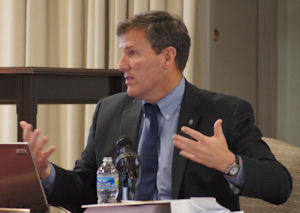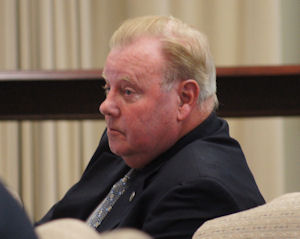About Bacon’s Rebellion
Bacon's Rebellion is Virginia's leading independent portal for news, opinions and analysis about state, regional and local public policy. Read more about us here.
A Bump in the Road
Under withering criticism for a lack of transparency, the Commonwealth Transportation Board has agreed to a one-month delay before formally endorsing the McDonnell administration's vision for the North-South Corridor.
by James A. Bacon
 In deference to a scathing letter from Congressman Frank Wolf, R-10, and personal appeals from two members of the General Assembly, the Commonwealth Transportation Board voted Wednesday to delay formal acceptance of the Northern Virginia North-South Corridor Master Plan by a month.
In deference to a scathing letter from Congressman Frank Wolf, R-10, and personal appeals from two members of the General Assembly, the Commonwealth Transportation Board voted Wednesday to delay formal acceptance of the Northern Virginia North-South Corridor Master Plan by a month.
Any recognition of the master plan would have been purely symbolic -- it represents no more than an aspirational vision for a north-south multimodal corridor west of Washington Dulles International Airport. Blocking the plan would not thwart any of the specific projects discussed within it. And the deferral was equally symbolic. Not a single member of the CTB expressed reservations of any kind about the plan. Its acceptance in June seems pre-ordained.
But in the trench warfare over new transportation projects, warring parties place great stock in even symbolic victories and defeats. And opposition to the linchpin segment of the 45-mile North-South corridor, the so-called Bi-County Parkway (also referred to as the Tri-County Parkway), is intense. The crux of the conflict centers on the alleged necessity of routing the Parkway through or around the Manassas National Battlefield Park. The interests of stakeholders as varied as the McDonnell administration, the National Park Service, Northern Virginia commuters and residents of nearby farms and subdivisions seem largely irreconcilable.
Approval of the Bi-County Parkway, which is moving along its own bureaucratic track, is not contingent upon acceptance of the North-South master plan. But accepting the master plan would confer legitimacy upon the Parkway. And that was enough to goad several Prince William County residents to travel to Richmond to address the CTB and to inspire two elected officials, Del. Tim Hugo, R-Centreville, and Bob Marshall, R-Manassas, to endure four hours of CTB tedium in order to speak on the behalf of constituents who had packed previous Northern Virginia gatherings to protest plans for the parkway.
 "Normally, we can't get 15 people to a town hall meeting. We had 400 people show up," Hugo told the CTB. "Congressman Wolf is not a flamethrower. I'm not a flamethrower." But both are concerned by how the project is progressing. The Bi-County Parkway, the delegate said, will create "a traffic armageddon."
"Normally, we can't get 15 people to a town hall meeting. We had 400 people show up," Hugo told the CTB. "Congressman Wolf is not a flamethrower. I'm not a flamethrower." But both are concerned by how the project is progressing. The Bi-County Parkway, the delegate said, will create "a traffic armageddon."
But the Parkway had its defenders, including representatives of the Loudoun County and Prince William chambers of commerce and an aide to Loudoun County Board Chair Scott York. Brian Fauls, manager-government affairs for the Loudoun Chamber, said Loudoun needs a north-south highway to improve access to Dulles airport. Like the ports in Hampton Roads, Dulles is regarded as an economic engine of the state. But unlike Hampton Roads, which is served by five existing Corridors of Statewide Significance, Dulles is served by none. The North-South corridor would remedy that deficiency.
Richard McCary, past-president of the Committee for Dulles, also pointed out that the corridor is needed to serve the massive population growth in eastern Loudoun/western Prince William projected by the Metropolitan Washington Council of Governments.
The Master Plan outlines several components to the corridor. One piece already exists -- Rt. 234 (the Prince William Parkway), which runs from Interstate 95 to Manassas. The corridor would continue north past the Battlefield Park and through the rural, western reaches of Prince William County -- the Bi-County Parkway -- and then tie into a northern segment aligned with Northstar Boulevard in Loudoun. Additional pieces of the corridor would include an east-west link to Dulles airport and a widening of Rt. 606 on the airport's western edge. VDOT has not yet developed a cost estimate for the projects.
The great sticking point is the middle segment where it would run along the western edge of the battlefield and through the so-called "rural crescent" of Prince William. According to the latest version of a deal negotiated between the National Park Service and the Virginia Department of Transportation, the Bi-County Parkway would align with the western half of a proposed battlefield bypass. When the Bi-County parkway is built, park authorities would close Rt. 234, a parallel north-south road that runs through the center of the park, and install unspecified traffic-calming measures on a section of U.S. 29 that runs east-west through the park. Traffic on those two roads, which park officials say disrupts the visitor experience, carry roughly 24,000 cars a day. In theory, completing the eastern half of the bypass will improve conditions for east-west commuters, but no one has identified a source of funds for that project.
In a presentation to the CTB, Charlie Kilpatrick, chief deputy commissioner of VDOT, provided some history. The mandate for the Manassas Battlefield Bypass originated from Congressional legislation passed in 1988, saying that the Secretary of Interior shall conduct a study regarding the relocation of U.S. 29 and Rt. 234 in the park. Planning has progressed in fits and starts since then. Kilpatrick stated that VDOT has conducted extensive public outreach and held a number of public hearings.
"What year is it now?" interjected Transportation Secretary Sean Connaughton.
"2013," responded Kilpatrick.
"Here we are, and the haven't even finished the final [Environmental Impact Statement]," said the secretary, who has often expressed his frustration with endless studies and endless delays associated with this and other transportation projects.
However, foes of the Bi-County Parkway contend that the public outreach was a sham. "VDOT's public notice last December for meeetings in Ashburn and Manassas in 2012 did not specify the names of any roads, communities or postal areas in Prince William and Loudoun," said Del. Marshall. With such vague descriptions, why would anybody bother to attend? Making matters worse, he added, Prince William VDOT did not correctly identify the meeting location until five days before the event.
Even if people did show up, the Northern Virginia hearings were devoid of meaningful detail, contended parkway foes. Most significantly, no one mentioned that VDOT and the NPS had agreed to effectively close U.S. 29 and Rt. 234 in the park, critical thoroughfares for local residents and area commuters.
"The citizens were not aware of this," said Mary Ann Ghadban, whose property would be affected by the parkway project. "The supervisors were not aware of this. The delegates were not aware of this." It was only through protracted digging that property owners uncovered VDOT's intentions regarding the two roads.
Congressmen Wolf addressed many of those points in a pointed letter addressed to Governor Bob McDonnell yesterday: "I have serious reservations about the North-South Corridor project and I want to take this opportunity to share my concerns with you."
The Congressman listed "lack of transparency" atop his list of concerns. "More public hearings must be held and more citizen input must be received before any final decision is made about the North-South Corridor," he wrote. "Few, if any, residents and landowners in this impacted area have been given notice of the proposed project."
Wolf, who sponsored the law authorizing creation of a battlefield bypass, said that the project had "morphed into something much larger than the language that was included in my 1988 legislation." He was concerned that grafting the battlefield bypass onto the north-south corridor would open up the rural crescent to development and close Pageland Lane, a two-lane road that many local residents rely upon to reach jobs and amenities in nearby Gainesville.
The congressman also opposed closing U.S. 29 and Route 234 before the entire bypass around the park was built. He wrote: "If the North-South Corridor project advances, NO roads should be closed until the bypass around the park is completed, as I stated in my 1988 legislation and echoed in a CTB resolution approved on June 15, 2006."
Hugo said that closing Rt. 234 and throttling U.S. 29 would send thousands of drivers onto a congested Interstate 66 or other overloaded local roads. While U.S. 29 might not be formally closed, he said, the programmatic agreement calls for unspecified "traffic calming" measures, the intent of which is to slow driving speeds and reduce the volume of traffic through the Battlefield Park.
 Responding to Wolf's concerns, Gary Garczynski, one of the CTB's Northern Virginia representatives and a Prince William developer, proposed deferring acceptance of the Master Plan and holding a major public hearing June 3. That hearing, he said, would have an "expanded presentation" and be followed by a meeting with residents of the residents of Pageland Lane.
Responding to Wolf's concerns, Gary Garczynski, one of the CTB's Northern Virginia representatives and a Prince William developer, proposed deferring acceptance of the Master Plan and holding a major public hearing June 3. That hearing, he said, would have an "expanded presentation" and be followed by a meeting with residents of the residents of Pageland Lane.
He didn't expect to change anyone's mind, Garczynski added. "We won't satisfy people who don't want to see that road. We are not going to cease opposition to the closer of 29. We go in with eyes open." But the hearings would show deference to Congressman Wolf, he said, and would "set the facts straight."

